Related Research Articles
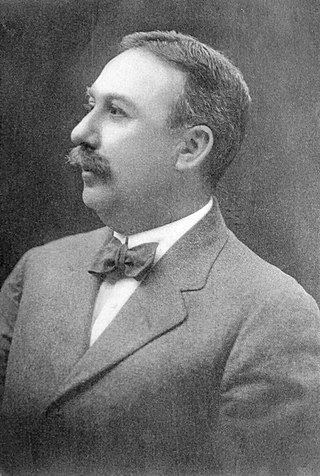
Edwin Stanton Porter was an American film pioneer, most famous as a producer, director, studio manager and cinematographer with the Edison Manufacturing Company and the Famous Players Film Company. Of over 250 films created by Porter, his most important include What Happened on Twenty-third Street, New York City (1901), Jack and the Beanstalk (1902), Life of an American Fireman (1903), The Great Train Robbery (1903), The European Rest Cure (1904), The Kleptomaniac (1905), Life of a Cowboy (1906), Rescued from an Eagle's Nest (1908), and The Prisoner of Zenda (1913).

Edison Studios was an American film production organization, owned by companies controlled by inventor and entrepreneur, Thomas Edison. The studio made close to 1,200 films, as part of the Edison Manufacturing Company (1894–1911) and then Thomas A. Edison, Inc. (1911–1918), until the studio's closing in 1918. Of that number, 54 were feature length, and the remainder were shorts. All of the company's films have fallen into the public domain because they were released before 1928.

Charles Stanton Ogle was an American stage and silent-film actor. He was the first actor to portray Frankenstein's monster in a motion picture in 1910 and played Long John Silver in Treasure Island in 1920.
The Boston Tea Party was a 1773 colonial protest action which presaged the American Revolution.

The Edison Manufacturing Company, originally registered as the United Edison Manufacturing Company and often known as simply the Edison Company, was organized by inventor and entrepreneur Thomas Edison and incorporated in New York City in May 1889. It succeeded the Edison United Manufacturing Company, founded in 1886 as a sales agency for the Edison Lamp Company, Edison Machine Works, and Bergmann & Company, which made electric lighting fixtures, sockets, and other accessories. In April 1894, the Edison laboratory's Kinetoscope operation, which was about to be commercialized, was brought under the Edison Company umbrella. In 1900, the United Edison Manufacturing Company was evidently succeeded by the New Jersey–incorporated Edison Manufacturing Company. The company's assets and operations were transferred to Thomas A. Edison, Inc. in 1911.

Rescued from an Eagle's Nest is a 1908 American silent action-drama film produced by Edwin S. Porter for Edison Studios and directed by J. Searle Dawley. It features the first leading screen role of the legendary American filmmaker D. W. Griffith, whose directorial debut was released just six months after he performed in this production. Griffith's casting in the Edison "photoplay" began when he found himself stranded and broke in New York City after a play he authored had failed. Desperate for money, he responded to Edison's offer to pay $15 to anyone who submitted a useable treatment or scenario based on the Puccini opera Tosca. Porter rejected Griffith's submission, but the studio executive did offer him the lead role in Rescued from an Eagle's Nest. A full print of this film survives in the extensive collection of moving images at the Museum of Modern Art. Only one other film in which Griffith appears as an actor survives.
James Searle Dawley was an American film director, producer, screenwriter, stage actor, and playwright. Between 1907 and the mid-1920s, while working for Edison, Rex Motion Picture Company, Famous Players, Fox, and other studios, he directed more than 300 short films and 56 features, which include many of the early releases of stars such as Douglas Fairbanks, Mary Pickford, Pearl White, Marguerite Clark, Harold Lloyd, and John Barrymore. He also wrote scenarios for many of his productions, including one for his 1910 horror film Frankenstein, the earliest known screen adaptation of Mary Shelley's 1818 novel. While film direction and screenwriting comprised the bulk of Dawley's career, he also had earlier working experience in theater, performing on stage for more than a decade and managing every aspect of stagecraft. Dawley wrote at least 18 plays as well for repertory companies and for several Broadway productions.

Alice's Adventures in Wonderland is a 10-minute black-and-white silent film made in the United States in 1910, and is based on Lewis Carroll's 1865 book of the same name.
Wallace McCutcheon Sr. was a pioneer cinematographer and director in the early American motion picture industry, working with the American Mutoscope & Biograph, Edison and American Star Film companies. McCutcheon's wealth of credits are often mixed up with the small handful of films directed by his son, Wallace McCutcheon Jr. (1884–1928).

The Moving Picture World was an influential early trade journal for the American film industry, from 1907 to 1927. An industry powerhouse at its height, Moving Picture World frequently reiterated its independence from the film studios.
By the Light of the Moon is a 1911 American single-reel silent film directed and filmed by Edwin S. Porter. It was produced for the Rex Motion Picture Company. It is one of the earliest examples of silhouette animation.

Dream of a Rarebit Fiend is a 1906 silent trick film directed by Edwin S. Porter for Edison Manufacturing Company. It is a seven-minute live-action film adaptation of the comic strip Dream of the Rarebit Fiend by American cartoonist Winsor McCay. The film was marketed as using several special effects in which "some of the photographic 'stunts' have never been seen or attempted before."

The Boston Tea Party is a 1915 American silent historical film directed by Eugene Nowland. The film is an extended remake of the 1908 film of the same name, also from Edison Studios, and depticts the events of the December 16, 1773, Boston Tea Party.
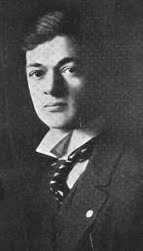
Wray Bartlett Physioc was an American film director, producer and artist. His film The Gulf Between (1917) was the first Technicolor film ever produced.
Edwin Harley was an actor in minstrel shows and later in silent films. He worked for the Reliance Majestic Company, Lasky Film Company, Albuquerque Film Company, Crown City Film Company, and Fine Arts Film Company.
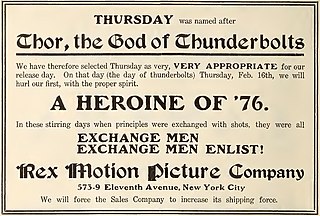
Rex Motion Picture Company was an early film production company in the United States.

Edwin Middleton (1865–1929) was a film director in the United States.

For the Cause of the South is a lost 1912 American silent film that portrayed a tragic, fictional romance set during the American Civil War. Directed by Bannister Merwin, the film was produced by Edison Studios, which was located in New York City, in The Bronx. The production starred Laura Sawyer, Benjamin Wilson, and Charles Ogle, with supporting characters played by Bessie Learn and James Gordon in the role of Confederate General Robert E. Lee.
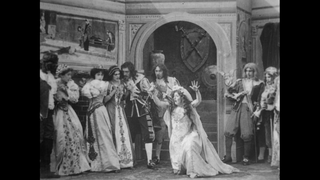
The Bride of Lammermoor is a 1909 American silent drama film directed by J. Stuart Blackton for Vitagraph Studios. Existing in fragmentary form, it is considered to be a lost film.
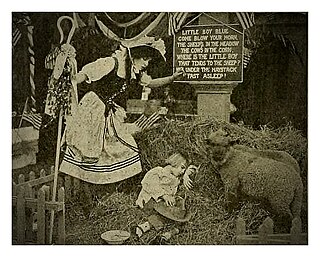
Little Boy Blue is a 1912 silent one-reel film produced by Lubin Manufacturing Company and distributed by the General Film Company. The movie was released on May 6, 1912. The movie featured child actor Raymond Hackett assuming the role of Harold and Marie Wierman playing Elizabeth, Harold's older sister.
References
- ↑ Langman, Larry; Borg, Ed (1989). "American Revolution". Encyclopedia of American War Films. Garland Reference Library of the Humanities. Garland Publishing. p. 22. ISBN 978-0-8240-7540-8.
Edison presented a one-reel depiction of the tea-dumping as early as 1908 titled 'The Boston Tea Party.'
- ↑ Holmes, Dr. John R. (1 June 2009). Remembering Steubenville: From Frontier Fort to Steel Valley. History Press. p. 101. ISBN 978-1-62584-247-3.
Edison Studios in New York led the pack, and in 1908, Charles Stanton Ogle, son of Steubenville preacher Joseph C. Ogle, appeared in the Edison feature The Boston Tea Party.
Alt URL - ↑ Chalmers, J.P., ed. (11 July 1908). "Film Review". The Moving Picture World. Vol. 3, no. 2. New York: The World Photographic Publishing Company. pp. 10, 18 – via Internet Archive.
- 1 2 Musser, Charles (1991). Before the Nickelodeon: Edwin S. Porter and the Edison Manufacturing Company . University of California Press. p. 418. ISBN 978-0-520-06986-2.
- ↑ Chalmers, J.P., ed. (8 August 1908). "Newspaper Comments on Film Subjects". The Moving Picture World. Vol. 3, no. 6. New York: The World Photographic Publishing Company. p. 6 – via Internet Archive.
- ↑ Chalmers, J.P., ed. (29 August 1908). "Newspaper Comments on Film Subjects". The Moving Picture World. Vol. 3, no. 2. New York: The World Photographic Publishing Company. p. 6 – via Internet Archive.